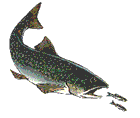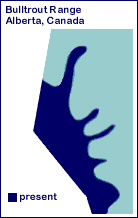|
Bull Trout [Salvelinus confluentus]:
Among the fish that could disappear from Alberta is the Bull Trout. And, as is often the case, the Bull Trout is threatened in much of its traditional range in North America, not just in Alberta. The Bull Trout belongs to a branch of the trout family called "chars," along with the Lake Trout, (Eastern) Brook Trout, and Dolly Varden (which was once considered to be the same species as the Bull Trout). Early naturalists had this to say about the fish: Bull Trout are by far the most active and handsome of the trout, they live in the coldest, cleanest and most secluded waters. No higher praise can be given to a Salmonid than to say, it is a charr. (Jordan and Evermann 1896) During the last 25 years there has been a significant reduction in both the number and distribution of Bull Trout, primarily as a result of over fishing, changes in habitat attributable to poor forestry and oil & gas exploration practices, and deliberate depletion of Bull Trout stocks due to incorrect knowledge of the role of the Bull Trout in the fishery ecosystems. In the early 1900s, fish-stocking programs brought new species to many streams. Some anglers saw Bull Trout as unwanted predators that fed on the more savoured trout species introduced by Man. From the 1930s to the 1950s, the removal of large Bull Trout from some streams was an accepted practice, because it was believed this removal would improve the survival of the other fish. Although the stocking of trout in these waters provided anglers with a greater variety of fishing opportunities, it also greatly increased the fishing pressure on the Bull Trout to the extent that its numbers began to decline steadily. At present, most anglers are not aware of the vulnerable state of Bull Trout populations and they have difficulty distinguishing this species from other trout and char. In additon, poor land management practices has contributed to the dramatic decline of this species. Alberta has limited numbers of the clean, sediment-free, groundwater-fed streams that bull trout need for spawning. Any alteration that causes erosion, increased silt, or changes in flow or temperature affects the number of trout that hatch and their ability to survive to maturity. Want to help? Join or make a donation to an organization that makes a difference.
|
Appearance: Bull trout can weigh up to 10 kg and measure 30-70 cm in length. The name was inspired by the large head and jaws in comparison to its body. The key to identifying this species is the absence of black spots on the dorsal fin. Food: Insects and other fish species, especially mountain whitefish. Breeding: Bull trout mature slowly, often spawning for the first time in their fifth or sixth year. Some females do not spawn every year. Water temperatures below 9 C trigger spawning between mid-August and mid-October. Trout seek out small, spring-fed streams that provide a continuous supply of oxygen for developing eggs. The female digs a nest or "redd" among the gravel where she deposits up to 5,000 eggs. Male fish swim nearby and release milky-white sperm or "milt" to fertilize the eggs. With the help of the current, the female then covers the eggs with gravel. The adults then move downstream for the winter.For the next six or seven months, the eggs incubate in their gravel nests. They begin to hatch during March and April. Lifespan: Up to 20 years. Risk factors: Overfishing, lack of appropriate spawning streams. Alberta has limited numbers of the clean, sediment-free, groundwater-fed streams bull trout need to spawn. Any alteration that causes erosion, increased silt, or changes in flow or temperature affects the number of trout that hatch and their ability to survive to maturity. Management and Outlook: The government has implemented several programs to protect bull trout populations:
Trout Unlimited Canada has embarked on an extensive sign campaign along streams throughout the entire eastern slopes of the Rocky Mountains in Alberta to caution anglers not to keep any bull trout.
|
 Most
Canadians have heard about the crisis in theWest and East coast fisheries, but
we don't hear or know much about the threatened native fish populations in our
own backyard. In fact, 12 species of fish in Alberta are at risk and there are
other which are throught to be at risk [information taken from Alberta Government:
Environmental Protection].
Most
Canadians have heard about the crisis in theWest and East coast fisheries, but
we don't hear or know much about the threatened native fish populations in our
own backyard. In fact, 12 species of fish in Alberta are at risk and there are
other which are throught to be at risk [information taken from Alberta Government:
Environmental Protection]. Status:
At one time, bull trout were common to all the major river systems flowing from
the eastern slopes of the Rocky Mountains as far as Alberta's prairie and parkland.When
anglers began stocking streams with new species in the early 1900s, many saw bull
trout as unwanted predators that fed on the more favored species. They removed
large bull trout to improve the survival of other fish.During the last 25 years,
bull trout numbers have declined even more, primarily as a result of overfishing.This
species is not in immediate danger of extinction in Alberta but could easily disappear
from some lakes and streams.
Status:
At one time, bull trout were common to all the major river systems flowing from
the eastern slopes of the Rocky Mountains as far as Alberta's prairie and parkland.When
anglers began stocking streams with new species in the early 1900s, many saw bull
trout as unwanted predators that fed on the more favored species. They removed
large bull trout to improve the survival of other fish.During the last 25 years,
bull trout numbers have declined even more, primarily as a result of overfishing.This
species is not in immediate danger of extinction in Alberta but could easily disappear
from some lakes and streams. 


